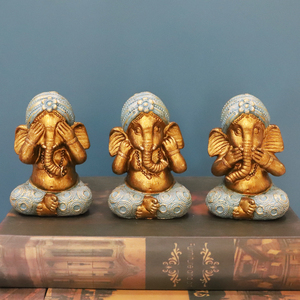
All categories
Featured selections
Trade Assurance
Buyer Central
Help Center
Get the app
Become a supplier

(414 products available)















































Buddhism Idols are also known as Buddhism statues. They come in different types and forms, including the following:
Buddha Statues
The Buddha statues are idols that represent Siddhartha Gautama, who is popularly known as the Buddha. The statues are different in many ways. Some of them are seated and meditating, while others are standing or reclining. The statues are also known for having different hand gestures, which are called mudras. The hand gestures include the touching the earth, teaching, and meditation mudras.
Bodhisattva Statues
The bodhisattva statues are idols that honor enlightened beings who decide to remain in the world to help others attain enlightenment. They include the Avalokiteshvara statues, which embody compassion. The Kannon statues are also known as the Japanese version of Avalokiteshvara. The Maitreya statues, which represent the future Buddha, and the Manjushri statues, which symbolize wisdom.
Guan Yin Statues
Guan Yin statues are also known as Kuan Yin. They are idols that represent Avalokiteshvara, the bodhisattine of compassion. Kuan Yin is venerated in most forms of Buddhism, and her statues are popular in Chinese Buddhism. The Kuan Yin statues are popularly known for their gentle and loving demeanor, and they are often depicted holding a vase of sacred water or a willow branch.
Other Buddhism Idols
Other types of Buddhism idols are various deities and figures who play important roles in Buddhist tradition. They include the Hindu deities and Tantric figures. The Hindu deities are idols of gods and goddesses that are integrated into Buddhism. They include Shiva, Parvati, and others. The Tantric figures are idols that represent the various practices and teachings in Buddhism. They are often depicted in a complex and symbolic manner.
When looking at the features of Buddhism idols, it is essential to know that they have different meanings and functions. Each idol has a specific role to play in the teachings of Buddhism.
The features of the Buddhism idols include the following:
Functions of Buddhism idols
Many people have an idol in their lives. Buddhism idols are used and applied in various ways. Here are some of them.
When choosing the right idol for a customer's needs, business buyers should consider several factors. First and foremost, they should consider the material used to make the idol. Buddhism idols are made using different materials, each with its unique meaning and advantages. Buyers should purchase idols made of materials they can easily care for and maintain. The size of the idol is also an important factor to consider. Buddhism idols come in different sizes, and buyers should get an idol size that is suitable for their space.
Business buyers should also consider the design of the idol. Buddhism idols have different designs, and buyers should get an idol with a design that resonates with them. The color of the idol is also an important factor to consider. Buyers should get an idol with a color they love and appreciate.
Business buyers should also take into account the craftsmanship of the idol. Idols that are well-crafted have more aesthetic value and appeal. They should also consider the price and purchase an idol they can afford.
Business buyers should also get an idol that is compatible with their spiritual beliefs. The energy of the idol is another important factor to consider. Buyers should get an idol with positive energy.
By taking into consideration the factors mentioned above, business buyers will be able to make a decision and choose the right idol that meets their needs.
Q: What are the different types of Buddhism idols?
A: Many idols of Buddhism exist, with each representing different teachings. Some of the common types are Shakyamuni Buddha, the Medicine Buddha, Buddha Amida, and Maitreya Buddha.
Q: Is it necessary to worship Buddhism idols?
A: Worshiping Buddhism idols is not a must. Buddhists can revere the idols as teachers and not deities. Therefore, they can honor the idols without worshiping them.
Q: Can someone become a Buddhist without worshiping the idols?
A: One can become a Buddhist without idolizing the statues. Buddhism is a philosophy that offers insights into life. Therefore, one can accept the teachings without necessarily venerating the idols.
Q: What does it mean to worship Buddhism idols?
A: Worshiping the idols means showing respect and honor to the teachings they propagate. It is a way of being grateful for the teachings and acknowledging them.